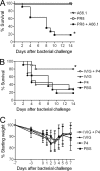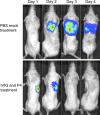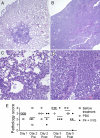Immunotherapy with a combination of intravenous immune globulin and p4 peptide rescues mice from postinfluenza pneumococcal pneumonia
- PMID: 21383090
- PMCID: PMC3088253
- DOI: 10.1128/AAC.00057-11
Immunotherapy with a combination of intravenous immune globulin and p4 peptide rescues mice from postinfluenza pneumococcal pneumonia
Abstract
Alternate therapies are needed for treatment of secondary bacterial pneumonia following influenza. The immunomodulatory peptide P4 has shown promise in mouse models of primary pneumococcal infection. Mice infected with influenza virus and then challenged with Streptococcus pneumoniae were treated with a combination of P4 peptide and intravenous immune globulin. Survival was improved from 20% to 80% in treated mice relative to controls. Clinical cure correlated with increased clearance of bacteria and decreased lung consolidation. Greater trafficking of professional phagocytic cells to the site of pneumococcal infection coupled with enhanced opsonophagocytosis as manifest by decreased surface display of Fcγ receptors (FcγR) on neutrophils and macrophages were associated with P4 peptide treatment. This suggests that the mechanism of action for improved clearance of bacteria engendered by P4 is through improved uptake by phagocytes mediated by IgG Fc-Fcγ receptor interactions following antibody-mediated opsonophagocytosis of bacteria. Antibody-based therapies, when coupled with immune modulators, such as P4 peptide, may be an effective tool together with antibiotics in our armamentarium against severe pneumonia.
Figures





Similar articles
-
A 28-aa pneumococcal surface adhesin A-derived peptide, P4, augments passive immunotherapy and rescues mice from fatal pneumococcal infection.J Infect Dis. 2009 Apr 15;199(8):1233-8. doi: 10.1086/597425. J Infect Dis. 2009. PMID: 19265478
-
Effective combination therapy for invasive pneumococcal pneumonia with ampicillin and intravenous immunoglobulins in a mouse model.Antimicrob Agents Chemother. 2001 Jan;45(1):316-8. doi: 10.1128/AAC.45.1.316-318.2001. Antimicrob Agents Chemother. 2001. PMID: 11120987 Free PMC article.
-
Evaluation of a novel therapeutic approach to treating severe pneumococcal infection using a mouse model.Clin Vaccine Immunol. 2009 Jun;16(6):806-10. doi: 10.1128/CVI.00120-09. Epub 2009 Apr 22. Clin Vaccine Immunol. 2009. PMID: 19386795 Free PMC article.
-
P4-mediated antibody therapy in an acute model of invasive pneumococcal disease.J Infect Dis. 2012 May 1;205(9):1399-407. doi: 10.1093/infdis/jis223. Epub 2012 Mar 29. J Infect Dis. 2012. PMID: 22457294
-
Immunogenicity differences of a 15-valent pneumococcal polysaccharide conjugate vaccine (PCV15) based on vaccine dose, route of immunization and mouse strain.Vaccine. 2017 Feb 7;35(6):865-872. doi: 10.1016/j.vaccine.2016.12.055. Epub 2017 Jan 10. Vaccine. 2017. PMID: 28087148 Review.
Cited by
-
Naturally occurring swine influenza A virus PB1-F2 phenotypes that contribute to superinfection with Gram-positive respiratory pathogens.J Virol. 2012 Sep;86(17):9035-43. doi: 10.1128/JVI.00369-12. Epub 2012 Jun 6. J Virol. 2012. PMID: 22674997 Free PMC article.
-
A Novel Innate Immune-Enhancement Strategy Combined with IVIG Rescues Mice from Fatal Staphylococcus aureus Septicemia.Int J Microbiol. 2011;2011:725483. doi: 10.1155/2011/725483. Epub 2011 Nov 16. Int J Microbiol. 2011. PMID: 22164166 Free PMC article.
-
Potential role for alternatively activated macrophages in the secondary bacterial infection during recovery from influenza.Immunol Lett. 2012 Jan 30;141(2):227-34. doi: 10.1016/j.imlet.2011.10.009. Epub 2011 Oct 20. Immunol Lett. 2012. PMID: 22037624 Free PMC article.
-
Immunoactivating peptide p4 augments alveolar macrophage phagocytosis in two diverse human populations.Antimicrob Agents Chemother. 2013 Sep;57(9):4566-9. doi: 10.1128/AAC.00742-13. Epub 2013 Jul 1. Antimicrob Agents Chemother. 2013. PMID: 23817378 Free PMC article.
-
Draft Genome Sequence of the Streptococcus pneumoniae Avery Strain A66.Genome Announc. 2015 Jun 25;3(3):e00697-15. doi: 10.1128/genomeA.00697-15. Genome Announc. 2015. PMID: 26112793 Free PMC article.
References
-
- Centers for Disease Control and Prevention. 2009. Bacterial coinfections in lung tissue specimens from fatal cases of 2009 pandemic influenza A (H1N1)—United States, May-August 2009. MMWR Morb. Mortal. Wkly. Rep. 58:1071–1074 - PubMed
-
- Christian H. A. 1944. The principles and practice of medicine. D. Appleton-Century Company, Inc., New York, NY
-
- Chudwin D. S. 1989. Prophylaxis and treatment of pneumococcal bacteremia by immune globulin intravenous in a mouse model. Clin. Immunol. Immunopathol. 50:62–71 - PubMed
-
- Domínguez-Cherit G., et al. 2009. Critically ill patients with 2009 influenza A(H1N1) in Mexico. JAMA 302:1880–1887 - PubMed
-
- Estenssoro E., et al. 2010. Pandemic 2009 influenza A in Argentina: a study of 337 patients on mechanical ventilation. Am. J. Respir. Crit. Care Med. 182:41–48 - PubMed
Publication types
MeSH terms
Substances
Grants and funding
LinkOut - more resources
Full Text Sources

